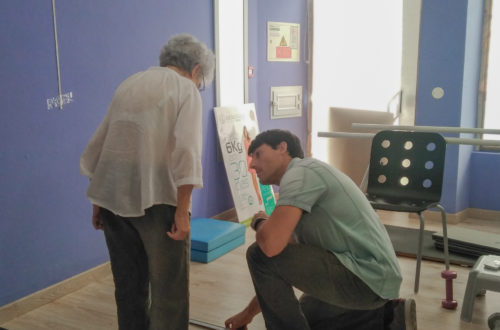Autores
Catarina LN Pereira, Jorge Bravo, Hugo Rosado, Gabriela Almeida
Título
A new affordance perception test to explain falls occurrence: preliminary results of stepping-forward task
Publicado
Revista BMC Health Services Research 2018, 18(Suppl 2):O172. p.90-91
Abstract
Background
Falls cause injury, dependence, and death. Identify the subjects that are potential fallers is essential for a successful prevention. Researchers developed several models and tests in order to diagnose individual’s risk of falling. Risk factors such as environmental hazards, strength, balance or dual tasks are commonly tested. However, their discriminative power is limited, indicating a gap which these tests do not address. The assessment on the perception of affordances for individual’s ability to perceive the critical boundary action, may fill this gap.
Objective
To analyse the appropriateness of a new stepping-forward test to ex- plain fall occurrence in community-dwelling adults, that assess per- ception and action boundary.
Methods
Participants were 266 women and 81 men aged 73.0 ± 6.4 years. They were assessed for fall occurrence (yes vs. no), and for stepping-forward and perception boundaries. Participants judged their maximum stepping-forward distance prior to the performance of the estimated task. Absolute Error (AE) [|estimated – real|] (cm) and Absolute Percent Error (APE) (%) were computed, and the Error Tendency (ET) was classified (underestimation vs. overestimation).
Results
Univariate binary regression analysis showed that all the described vari- ables explain significantly fall occurrence (p < 0.05). Data showed that, for each additional cm estimated in the stepping-forward test, the likeli- hood of falling decreased on 2.9%, OR: 0.971 (95%CI: 0.957-0.986), and for each additional cm performed in the test, this likelihood decreased on 4.0%, OR: 0.960 (95%CI: 0.945-0.975). Furthermore, data showed that for each additional cm computed as AE, the likelihood of falling de- creased on 3.6%, OR: 0.964 (95%CI: 0.933-0.996), and for each additional 1% computed as APE this likelihood decreased on 0.9%, OR: 0.991 (95%CI: 0.969-1.013). Finally, data showed that subjects reporting an ET of underestimation were less 47.7% likely for falling, OR: 0.523 (95%CI: 0.315-0.867), than subjects showing an ET of overestimation.
Conclusions
The new stepping-forward affordance perception test evidenced to be useful to determine the risk of fall occurrence. A higher estimation of maximum distance achieved or a higher real performance on the test were associated with a lower risk of falling. Further, a higher AE and an underestimation tendency showed to be associated with a decreased risk of falling. This suggests that is the marge of security provided by the higher performance ability, in contrast with a lower perception of affordance, which is protective and avoids falls.
Keywords
Aging, Falling risk, Boundary action, Perception


